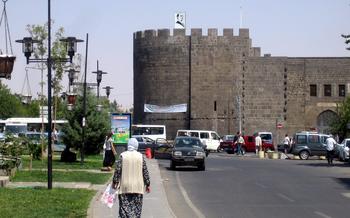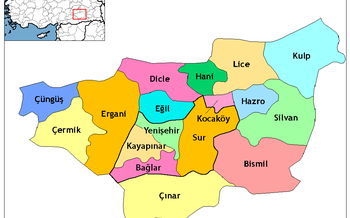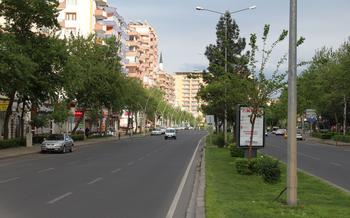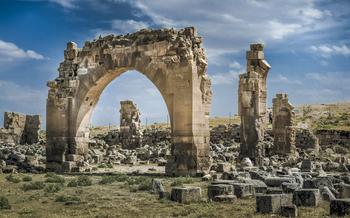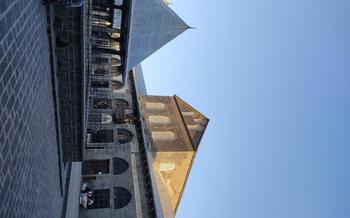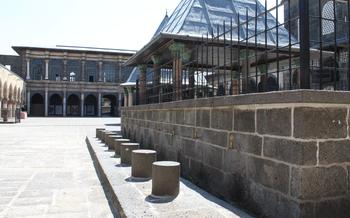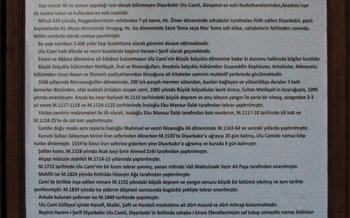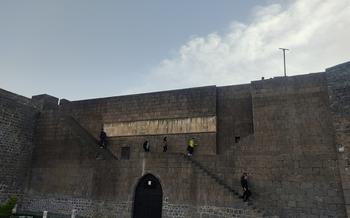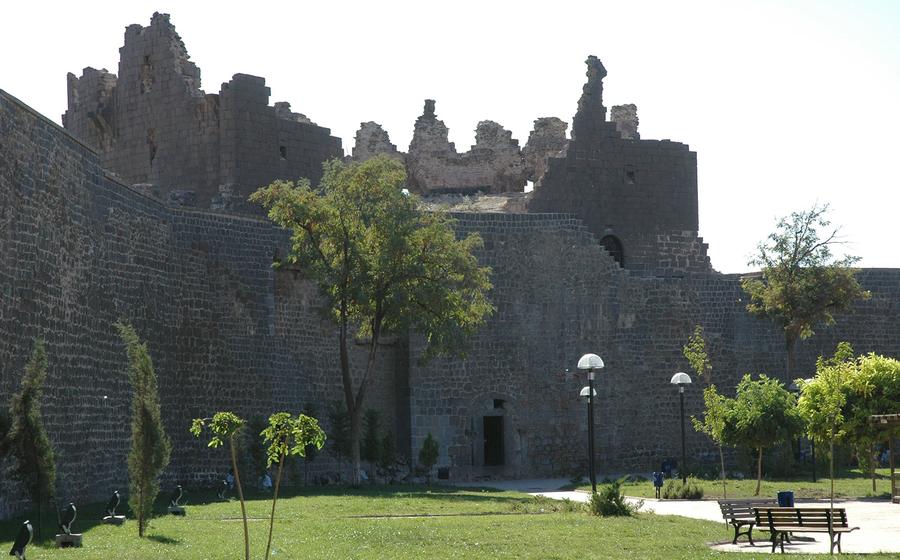
Diyarbakır City Walls
- History of the Diyarbakır City Walls
- Architectural Features of the Diyarbakır City Walls
- The Gates of Diyarbakır
- Walking along the Walls
- Visit the İçkale
- Explore the Old City
- Take a Hot Air Balloon Ride
- Visit the Surp Giragos Armenian Church
- Diyarbakır Museum: A Journey Through History and Culture
- Explore the City's Cuisine
- Attend a Cultural Event
- Shopping in the Old Bazaar
- Visit the Great Mosque of Diyarbakır
- Insider Tip
History of the Diyarbakır City Walls
Diyarbakır's imposing city walls, a testament to the city's rich and turbulent past, have stood guard over the city for centuries. The earliest traces of these fortifications date back to the 4th century BC, during the reign of the Roman Emperor Constantius II. The walls were initially constructed as a defense against the Sassanid Empire, a powerful Persian dynasty. Over the centuries, they underwent several expansions and modifications under various rulers, including the Byzantines, Arabs, and Seljuks.
The city's strategic location on the Silk Road made it a significant trade hub and a frequent target for invaders. The walls played a crucial role in protecting Diyarbakır from attacks, ensuring its survival and prosperity. The walls' effectiveness as a defensive structure is evident from the city's successful resistance against numerous sieges throughout history. In 2015, the Diyarbakır City Walls, along with the Hevsel Gardens, were recognized as a UNESCO World Heritage Site, solidifying their status as a cultural treasure of global significance.
Architectural Features of the Diyarbakır City Walls
The Diyarbakır City Walls, a UNESCO World Heritage site, stand as a testament to the city's rich history and architectural prowess. The walls, constructed over centuries, showcase a unique combination of defensive features and architectural influences.
The most distinctive aspect of the walls lies in their double-wall structure, separated by a moat. The outer wall, standing at an impressive height, forms the first line of defense. The inner wall, slightly shorter, provides additional protection and serves as a second barrier. The moat, once filled with water, further enhances the defensive capabilities of the fortifications.
The walls are punctuated by massive gates and towers, each serving a specific purpose. The gates, some of which still bear their original names, provided controlled access to the city. The towers, strategically positioned along the walls, offered vantage points for surveillance and defense.
Defensive mechanisms like crenellations, allowing archers to fire arrows through narrow slits, and machicolations, projecting structures designed to drop objects on attackers, further strengthened the walls' defensive capabilities.
The architectural influences visible in the walls reflect Diyarbakır's diverse history. Elements of Roman, Byzantine, Islamic, and Armenian architecture blend harmoniously to create a unique architectural masterpiece. The walls stand as a testament to the city's rich cultural heritage, showcasing the fusion of different civilizations that have shaped Diyarbakır over the centuries.
The Gates of Diyarbakır
The massive city walls of Diyarbakır are punctuated by 18 monumental gates, each with its own unique history and architectural features. These gates served as the main entry points to the city, providing access to different quarters and neighborhoods. The most significant gate is the Eğil Gate, located on the southeastern side of the walls. Constructed in the 4th century AD, it is one of the oldest gates and features a double-arched entrance. The Eğil Gate was once connected to a drawbridge that spanned the moat, adding to its defensive capabilities. Other notable gates include the Yenişehir Gate, known for its intricate carvings, and the Urfa Gate, which leads to the road connecting Diyarbakır to the city of Urfa. These gates not only served as defensive structures but also played a crucial role in the city's trade and cultural exchange, allowing for the movement of people and goods in and out of Diyarbakır.
Walking along the Walls
A leisurely stroll atop the Diyarbakır City Walls is an experience that transports you back in time. The walkway, accessible to visitors, offers a unique perspective of the city and its surroundings. The walls stretch for approximately 5 kilometers, making the walk a captivating journey.
As you make your way along the ramparts, marvel at the intricate fortifications and defensive mechanisms that protected Diyarbakır for centuries. The crenellations and machicolations, designed to repel enemy attacks, stand as testaments to the city's resilience.
The highlight of the wall walk is the panoramic views it offers. From up here, you can capture breathtaking vistas of the old city, with its labyrinthine streets, historic landmarks, and a sea of rooftops. The views extend beyond the city limits, showcasing the vast plains and rugged mountains that cradle Diyarbakır.
Walking on these ancient ramparts is like stepping into a medieval tale. The worn stones beneath your feet whisper stories of sieges, conquests, and the lives of those who once patrolled these walls. It's an experience that will stay etched in your memory long after you leave Diyarbakır.
Visit the İçkale
Within the formidable embrace of Diyarbakır's city walls lies a hidden gem, the İçkale, an ancient citadel that stands as a testament to the city's rich and storied past. A journey into the İçkale is a journey into the heart of Diyarbakır's history, culture, and architectural heritage.
The İçkale, meaning "inner castle" in Turkish, was constructed during the Roman period as a military fortress. Over the centuries, it underwent numerous modifications and expansions, reflecting the changing hands that ruled over Diyarbakır. Its strategic location made it a crucial defensive point, and its massive walls and towers provided an impenetrable barrier against invaders.
Explore the Old City
Beyond the Diyarbakır City Walls, the old city beckons with its labyrinthine streets and hidden gems. Step into a world where history whispers from the walls of ancient mosques, churches, and madrasas. Admire the intricate carvings and vibrant tiles adorning the facades of traditional houses, each narrating tales of the city's rich past.
Immerse yourself in the vibrant local markets, where the air is alive with the sounds of haggling vendors and the scent of exotic spices. Discover unique handicrafts, colorful textiles, and gleaming jewelry, reflecting the artistry and craftsmanship of Diyarbakır's people. Let the old city's charm envelop you as you explore its nooks and crannies, uncovering hidden courtyards, serene gardens, and historic landmarks.
Engage with the locals, who warmly welcome visitors with their infectious hospitality. Savor the flavors of Kurdish cuisine at traditional restaurants, where mouthwatering dishes like çiğ köfte and mırra tantalize your taste buds. Experience the vibrant cultural heritage of Diyarbakır through its music, dance, and storytelling traditions, which showcase the city's diverse ethnic and religious tapestry.
Whether you're a history buff, an architecture enthusiast, or simply someone seeking an authentic cultural experience, the old city of Diyarbakır promises an unforgettable journey through time and tradition.
Take a Hot Air Balloon Ride
Experience the magic of Diyarbakır from a unique perspective with a hot air balloon ride. Soar above the city walls and witness the stunning panorama of the ancient city and the surrounding countryside. Float gently over the Tigris River and marvel at the intricate details of the city's architecture. As the sun rises, bathe in the warm glow that illuminates the landscape, casting a golden hue over the city and its iconic walls.
Several reputable hot air balloon companies operate in Diyarbakır, offering a range of flight options and durations. Whether you prefer a leisurely ride or an extended adventure, you'll find a package that suits your preferences. Prices typically start from around $150 per person, and flights usually last for an hour or more.
Safety is paramount during hot air balloon rides, and all operators adhere to strict regulations and procedures. Experienced pilots and crew members ensure that your flight is smooth, safe, and enjoyable. Detailed safety briefings are provided before takeoff, and all balloons are thoroughly inspected and maintained.
Don't miss this opportunity to experience the thrill of floating above one of the world's oldest cities. Capture breathtaking aerial shots of Diyarbakır's cityscape and create memories that will last a lifetime.
Visit the Surp Giragos Armenian Church
Diyarbakır's diverse cultural heritage is reflected in the presence of the Surp Giragos Armenian Church, the oldest Armenian church in the world. Dating back to the 4th century, this ancient structure stands as a testament to the city's rich history and religious diversity. Its unique architectural features, including its iconic dome and intricate carvings, showcase the artistic prowess of Armenian craftsmanship.
As a pilgrimage site for Armenian Christians worldwide, Surp Giragos holds immense spiritual significance. Every year, thousands of pilgrims flock to this holy site to pay homage and seek blessings. The church's interior is adorned with stunning frescoes, vibrant stained glass windows, and meticulously preserved artifacts that offer a glimpse into the rich history of the Armenian community in Diyarbakır.
Beyond its religious significance, Surp Giragos serves as a cultural and historical landmark, symbolizing the harmonious coexistence of different faiths in the city. Standing tall amidst the bustling streets of Diyarbakır, this ancient church invites visitors to delve into the depths of Armenian culture and heritage, fostering a sense of understanding and appreciation for the city's diverse tapestry of traditions.
Diyarbakır Museum: A Journey Through History and Culture
The Diyarbakır Museum stands as a testament to the city's rich history and diverse heritage. Within its walls, visitors embark on a journey through time, exploring the region's ancient past and vibrant present. The museum's collection boasts a treasure trove of artifacts and exhibits that showcase the cultural tapestry of Diyarbakır.
Archaeological findings from excavations in the city and surrounding region form the heart of the museum's collection. These artifacts provide a glimpse into the lives of Diyarbakır's earliest inhabitants, revealing their customs, beliefs, and artistic expressions. From prehistoric tools to intricate jewelry, each piece tells a story of a bygone era.
Ethnological displays showcase the unique traditions and customs of Diyarbakır's diverse communities. Traditional costumes, household items, and agricultural tools offer insights into the daily lives of the people who have shaped the city's cultural landscape. Visitors can learn about the region's nomadic heritage, its vibrant festivals, and the intricate craftsmanship that has been passed down through generations.
The museum also houses a collection of Islamic art and calligraphy, highlighting Diyarbakır's rich religious heritage. Intricate manuscripts, ceramic tiles, and decorative objects showcase the artistry and devotion of the region's Muslim artisans. The museum's collection provides a comprehensive overview of Diyarbakır's past and present, offering visitors a deeper understanding of the city's cultural and historical significance.
Explore the City's Cuisine
Diyarbakır's culinary scene is a vibrant fusion of flavors, reflecting its rich cultural heritage and the diverse influences that have shaped the city's history. From the iconic çiğ köfte, a spicy raw meatball dish, to the aromatic mırra, a fermented dairy drink, Diyarbakır's cuisine is a must-try for food enthusiasts.
Çiğ Köfte: A Culinary Delight Çiğ köfte, a beloved street food in Diyarbakır, is a mixture of finely ground raw meat, bulgur, spices, and vegetables. It is typically served with fresh vegetables, such as lettuce, tomatoes, and onions, and is often accompanied by a squeeze of lemon juice. The unique flavor and texture of çiğ köfte make it a favorite among locals and visitors alike.
Mırra: A Refreshing Beverage Mırra, a fermented dairy drink, is another local specialty. It is made from sheep or goat milk that has been fermented for several days, resulting in a tangy and slightly sour flavor. Mırra is often served chilled and is a popular accompaniment to meals or as a refreshing drink on hot summer days.
Famous Restaurants and Street Food Vendors Diyarbakır is home to a variety of restaurants and street food vendors, each offering their own take on local cuisine. From traditional Kurdish restaurants serving home-style dishes to modern eateries showcasing innovative culinary creations, there is something for every palate in Diyarbakır.
Culinary Traditions and Regional Specialties Kurdish cuisine, with its emphasis on fresh ingredients, bold flavors, and hearty dishes, plays a significant role in Diyarbakır's culinary landscape. Regional specialties include dolma, stuffed grape leaves or vegetables, and keşkek, a dish made from pounded wheat and meat.
Exploring Diyarbakır's cuisine is an essential part of experiencing the city's rich cultural heritage. Whether you're savoring the spicy kick of çiğ köfte, sipping on a glass of refreshing mırra, or indulging in a traditional Kurdish feast, Diyarbakır's culinary delights are sure to leave a lasting impression.
Attend a Cultural Event
Diyarbakır's vibrant cultural scene offers a rich tapestry of experiences for visitors. Immerse yourself in the city's unique heritage through its music festivals, art exhibitions, and traditional performances.
One of the highlights is the Diyarbakır Music Festival, held annually in the summer. This prestigious event showcases renowned local and international musicians, presenting a diverse range of genres from traditional Kurdish music to contemporary fusion sounds.
For those seeking a more intimate experience, the city's many cultural centers and theaters host regular performances of traditional music and dance. Don't miss the chance to witness the mesmerizing Sufi music and dengbej performances, where traditional Kurdish storytelling meets enchanting melodies.
To stay updated on upcoming cultural events, check the local tourism websites or inquire at your hotel or tour guide. These events provide an excellent opportunity to connect with the local community and gain a deeper understanding of Diyarbakır's rich cultural heritage.
Shopping in the Old Bazaar
Immerse yourself in the vibrant atmosphere of the Old Bazaar, a bustling marketplace located in the heart of Diyarbakır's old city. This labyrinthine network of narrow streets and alleyways is a treasure trove of traditional handicrafts, souvenirs, and local delicacies.
As you wander through the bazaar, you'll be greeted by the sights and sounds of local vendors displaying their wares, from colorful textiles and intricate pottery to gleaming jewelry and aromatic spices. The air is filled with the scent of freshly baked bread, roasted coffee, and traditional Kurdish dishes wafting from nearby eateries.
Take your time to browse the stalls and discover unique handmade items, such as beautifully embroidered fabrics, hand-woven rugs, intricately carved wooden artifacts, and gleaming copperware. You can also find a wide selection of local jewelry, including intricate gold and silver pieces, as well as semi-precious stone accessories.
Remember, bargaining is a customary practice in the Old Bazaar, and it's considered a sign of respect. Engage in friendly negotiations with the vendors, but always be mindful of local customs and traditions.
As you explore the bazaar, don't miss the opportunity to indulge in some local delicacies. Sample the famous çiğ köfte, a spicy raw meatball dish, or savor the rich flavor of mırra, a traditional Kurdish coffee. You'll also find an array of fresh fruits, nuts, and sweets to satisfy your sweet tooth.
The Old Bazaar is not just a place for shopping; it's a cultural experience that offers a glimpse into the heart of Diyarbakır's vibrant heritage. Immerse yourself in the sights, sounds, and flavors of this bustling marketplace, and take home a piece of Diyarbakır's rich cultural tapestry.
Visit the Great Mosque of Diyarbakır
**The Great Mosque of symbol of the city's rich religious heritage. Constructed during the Seljuk era in the 11th century, the mosque stands as a testament to the architectural prowess and devotion of its builders. Its imposing facade, intricate carvings, and stunning interior decorations leave visitors in awe.
The mosque showcases a blend of Islamic and Anatolian architectural styles, with its massive dome, pointed arches, and elegant minarets. The interior is adorned with intricate Islamic calligraphy, colorful tiles, and intricate woodwork, creating a serene and awe-inspiring atmosphere. The grand prayer hall, with its rows of columns and high ceiling, can accommodate thousands of worshippers.
Beyond its architectural beauty, the Great Mosque holds deep religious significance. It has been a central place of worship for Muslims in Diyarbakır for centuries and continues to attract worshippers and visitors from around the world. Its role as a center of Islamic learning and scholarship has also contributed to its enduring importance.
Visiting the Great Mosque of Diyarbakır is a must for anyone interested in history, architecture, or religion. Whether you are a devout Muslim or simply an appreciative traveler, the mosque's grandeur and spiritual aura will leave a lasting impression.
Insider Tip
- Diyarbakır is best enjoyed in the spring (April-May) or autumn (September-October) when the weather is mild and pleasant.
- Consider hiring a local tour guide for an in-depth exploration of the city's history and hidden gems. They can provide unique insights and anecdotes that enhance your experience.
- Dress modestly and respectfully when visiting religious sites or conservative areas. Cultural sensitivity is essential to ensure a positive interaction with the locals.
- Diyarbakır hosts several festivals and events throughout the year, including the Diyarbakır International Short Film Festival, the Komagene Civilization Festival, and the Suruç International Peace Festival. These events offer a glimpse into the city's diverse culture and heritage.

